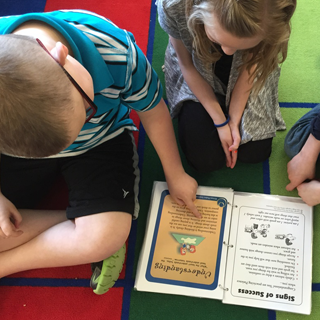Great schools look at themselves through a character lens to assess how everything happening in school affects the character of students. A comprehensive approach weaves the teaching of character into every aspect of the school culture.


Isolated projects can have their benefits but things really start to take shape when everyone is on board with the initiative, working together, and finding every opportunity to infuse character into day-to-day activities.

While many schools have several projects or programs in place that help young people develop their character, an intentional and holistic approach will enhance and deepen these initiatives. It’s easy to find ways to connect existing practices to character development but by being proactive and systematic, you can plan out how all the pieces fit together.
This kind of approach is not quick or easy, but what we have found over 20+ years is that the intentional approach makes all the difference. Working with a character curriculum can be helpful but a comprehensive initiative goes far beyond the curriculum.


School Example

Many schools that have now been certified as National Schools of Character have told us that they struggled for years to move from piecemeal to comprehensive, but once everyone was on board, they started seeing all the results through their school climate surveys, decreases in disciplinary incidents, and just how the school “felt.” The final example can’t really be quantified, but you’ll see that over time, the culture of the school shifts to become more caring, thoughtful, and peaceful.


How Do You Take a Holistic Approach?
It sounds great to say that your approach will be “holistic” or “systemic,” but what does that really mean? It starts through careful review: think through your school practices, your curriculum, your extracurriculars and what “just happens.” How do they affect the character of your students? Expecting students to be respectful in class but then ignoring rudeness in the hallways sends a message that character is only important “sometimes.”
This review of practices should include not just what is in your code of conduct, but it should also look into the hidden curriculum:
What do students learn from the interactions between teachers and students, or parents and staff?
?
How do students think about the world based on how they are treated differently at school, or how discipline is handled?
?
We’re all character educators whether we know it or not. Students watch us modeling behavior every day. Better to be intentional in our approach and aware of the messages we could be sending.
Digging into these questions can begin to reveal the experiences of students that have a tremendous, incremental impact on their character development. By being intentional and proactive, staff can take steps to help develop character, drawing on research and best practices, rather than simply waiting for a “teachable moment” to pop up.

Self-Reflection
Very few schools truly look at everything through a character lens. Reflecting on policies, procedures, and your school culture, what aspects of your day to day school business needs to be re-evaluated through a character lens?
What data in your school has been used to drive planning for character initiatives? If data hasn’t been driving planning, take some time to determine which data might be impactful.
[wp_quiz id=”4096″]
Research that Supports Principle 3
![]()
“SEL, (Social, Emotional Learning), is the process of acquiring and effectively applying the knowledge, attitudes, and skills necessary to recognize and manage emotions; developing caring and concern for others; making responsible decisions; establishing positive relationships; and handling challenging situations capably.”
Social and Emotional Learning, by Joseph E. Zins University of Cincinnati, Cincinnati, OH, and Maurice J. Elias of Rutgers University, New Brunswick, NJ, source
![]()
For more on Social and Emotional Learning:
CASEL-Collaborative for Academic, Social, and Emotional Learning, www.casel.org

Authored by Tamra Nast and Sora Wondra

